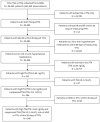Tachycardia in hyperthyroidism: Not so common
- PMID: 36054093
- PMCID: PMC9439220
- DOI: 10.1371/journal.pone.0273724
Tachycardia in hyperthyroidism: Not so common
Abstract
Objective: The commonly held association of hyperthyroidism with sinus tachycardia and widened pulse pressure (PP) has not been reassessed in decades despite patients with hyperthyroidism in current practice not always present with these signs. The study objective was to assess prevalence and variability of sinus tachycardia and widened PP in present day among individuals with different degrees of hyperthyroidism.
Methods: Data was collected retrospectively from 248 adult patients in an outpatient setting with biochemical evidence of hyperthyroidism, recorded heart rate (HR) and blood pressure (BP) who were not treated with medications that can influence these parameters.
Results: Mean age was 42.0 ± 14.2 years with 66.9% being female. Median free thyroxine (fT4) level was 3.49 (IQR 2.42-4.58) ng/dL and thyroid stimulating hormone (TSH) 0.02 (IQR 0.01-0.03) mIU/L. Tachycardia, defined as HR >100 bpm, was present in 28.2%. In the lowest and highest fT4 quartiles, tachycardia was present in 16.4% and 38.7% respectively. Using logistic regression, tachycardia was associated with higher fT4 and diastolic BP. More lenient outcome of tachycardia with HR >90 bpm was seen in 47.2%. Widened PP, defined as >50 mmHg, was observed in 64.1% of patients and correlated with higher fT4 and BP.
Conclusions: Tachycardia is not a common feature of hyperthyroidism today. The relatively infrequent finding of tachycardia in this study compared to older studies may reflect differences in the way medicine is practiced today. The increased ordering of thyroid function tests most likely unmasked cases of mild or asymptomatic thyrotoxicosis. A widened PP was a more prevalent clinical finding in this study.
Conflict of interest statement
The authors have declared that no competing interests exist.
Figures



References
MeSH terms
Substances
LinkOut - more resources
Full Text Sources
Medical
Miscellaneous

